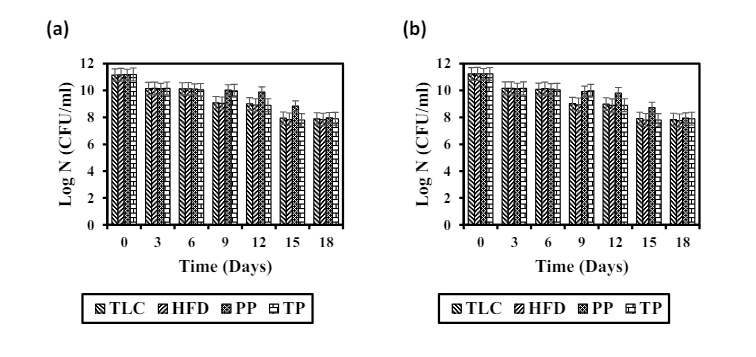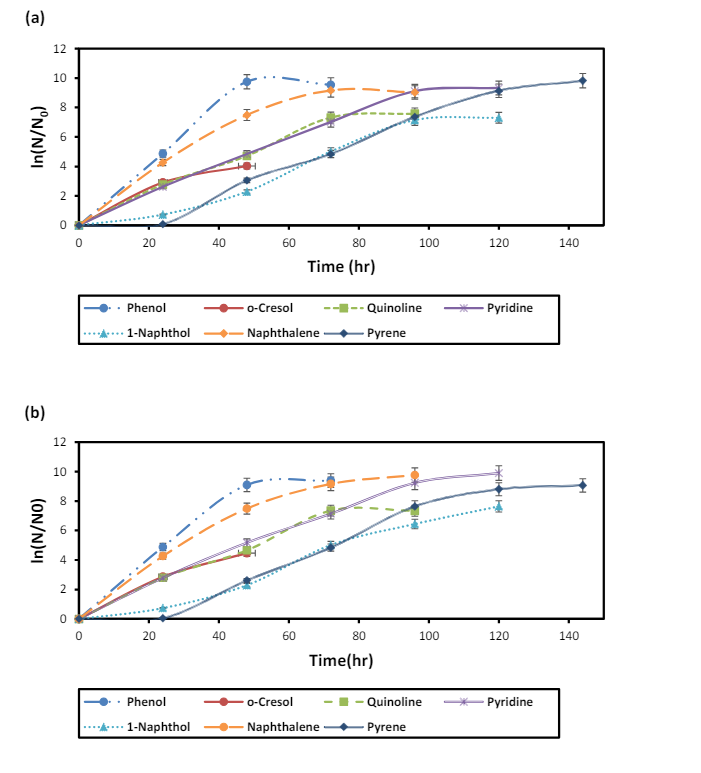Summary/Abstract: This invention shows the growth and degradation capabilities of P. aeruginosa and E. aurantiacum on hazardous organic compounds (HOCs). Both bacteria showed significant growth and degradation abilities on various HOCs, with preservation techniques using paper discs and corncob matrices demonstrating successful long-term storage of bacterial cells at room temperature for up to six months. Growth and degradation assays after preservation confirmed the retained activity of both free and immobilized bacterial cells on pyrene. Overall, the study highlights the potential of paper and corncob matrices for cost-effective bacterial preservation without refrigeration, offering promising applications in bioremediation and beyond.
- Acclimatization and Substrate Specificity: HOC degrading bacteria are acclimatized on a sterile mineral medium with substrates and specific HOCs like phenol, o-cresol, 1-naphthol, quinoline, naphthalene, pyridine, and pyrene, ensuring optimal adaptation and performance.
- Immobilization on Diverse Carriers: Bacteria are immobilized on carriers such as paper discs or corncob, providing stability and protection. This method uses widely available, low-cost materials, enhancing practicality and scalability.
- Protective Agents for Enhanced Stability: Incorporates protective agents to preserve bacterial viability, allowing long-term storage at ambient temperatures.
- Innovative Carrier Preparation: Corncob carriers undergo washing, drying, grinding, and chemical treatment to produce a fine powder (0.5–1 mm), ensuring effective immobilization and protection of bacteria.
- Inoculation and Storage Process: Paper discs are coated with protective agents, inoculated with bacterial suspension, dried, and stored. Corncob powder is mixed with bacterial suspension and stored similarly, enabling simple and efficient preservation.
- Acclimatization and Substrate Specificity: HOC degrading bacteria are acclimatized on a sterile mineral medium with substrates and specific HOCs like phenol, o-cresol, 1-naphthol, quinoline, naphthalene, pyridine, and pyrene, ensuring optimal adaptation and performance.
- Immobilization on Diverse Carriers: Bacteria are immobilized on carriers such as paper discs or corncob, providing stability and protection. This method uses widely available, low-cost materials, enhancing practicality and scalability.
- Protective Agents for Enhanced Stability: Incorporates protective agents to preserve bacterial viability, allowing long-term storage at ambient temperatures.
- Innovative Carrier Preparation: Corncob carriers undergo washing, drying, grinding, and chemical treatment to produce a fine powder (0.5–1 mm), ensuring effective immobilization and protection of bacteria.
- Inoculation and Storage Process: Paper discs are coated with protective agents, inoculated with bacterial suspension, dried, and stored. Corncob powder is mixed with bacterial suspension and stored similarly, enabling simple and efficient preservation.
The prototype's inputs are diverse, serving various functions in the preservation and storage process. Substrates, such as pyrene and other hazardous organic compounds like phenol, o-cresol, 1-naphthol, quinoline, naphthalene, and pyridine, provide the necessary nutrients for bacterial growth during acclimatization. Hazardous organic compounds act as the target substrates for bacterial degradation, driving the remediation process. Protective agents, including acacia gum powder, agar, PVA, gelatin, and glycerol, play a crucial role in safeguarding the bacteria during immobilization, enhancing their viability during storage. The coating of paper discs with protective agents was done at a slightly increased temperature range of 40°C to 45°C, ensuring optimal adhesion and effectiveness. Finally, carrier materials like paper discs and corncob powder serve as the platforms for immobilizing the acclimatized bacteria, facilitating their long-term preservation and transportation under ambient conditions.
4
- Pollution Reduction: Effective bioremediation of hazardous organic compounds leads to cleaner soil and water.
- Cost Savings: Eliminates the need for expensive refrigeration equipment.
- Accessibility: Low-cost, easy implementation benefits areas lacking infrastructure.
- Sustainability: Uses natural, locally available materials, reducing reliance on synthetic chemicals.
- Reduced Emissions: Improves bioremediation efficiency, indirectly reducing greenhouse gas emissions.
Biotechnology, Waste Management, Water Treatment, Oil and Gas, Sustainable Farming, Textile and Dye, Pharmaceuticals
- Bioremediation: Treatment of hazardous waste oil spills and pollutants in various environments.
- Agriculture: Remediation of soil and water contaminated by agricultural chemicals and livestock waste.
- Water Resource Management: Purification of drinking water and treatment of aquaculture effluents.
- Urban Development: Cleanup of contaminated sites for urban renewal projects.
- Waste Management: Treatment of landfill leachate and organic waste streams.
202021023129
481593


